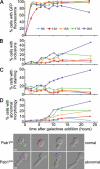A yeast model for polyalanine-expansion aggregation and toxicity
- PMID: 21508314
- PMCID: PMC3113764
- DOI: 10.1091/mbc.E11-01-0037
A yeast model for polyalanine-expansion aggregation and toxicity
Abstract
Nine human disorders result from the toxic accumulation and aggregation of proteins with expansions in their endogenous polyalanine (polyA) tracts. Given the prevalence of polyA tracts in eukaryotic proteomes, we wanted to understand the generality of polyA-expansion cytotoxicity by using yeast as a model organism. In our initial case, we expanded the polyA tract within the native yeast poly(Adenine)-binding protein Pab1 from 8A to 13A, 15A, 17A, and 20A. These expansions resulted in increasing formation of Pab1 inclusions, insolubility, and cytotoxicity that correlated with the length of the polyA expansion. Pab1 binds mRNA as part of its normal function, and disrupting RNA binding or altering cytoplasmic mRNA levels suppressed the cytotoxicity of 17A-expanded Pab1, indicating a requisite role for mRNA in Pab1 polyA-expansion toxicity. Surprisingly, neither manipulation suppressed the cytotoxicity of 20A-expanded Pab1. Thus longer expansions may have a different mechanism for toxicity. We think that this difference underscores the potential need to examine the cytotoxic mechanisms of both long and short expansions in models of expansion disorders.
Figures











Similar articles
-
Deep mutational scanning of an RRM domain of the Saccharomyces cerevisiae poly(A)-binding protein.RNA. 2013 Nov;19(11):1537-51. doi: 10.1261/rna.040709.113. Epub 2013 Sep 24. RNA. 2013. PMID: 24064791 Free PMC article.
-
Pleiotropic effects of PAB1 deletion: Extensive changes in the yeast proteome, transcriptome, and translatome.PLoS Genet. 2024 Sep 5;20(9):e1011392. doi: 10.1371/journal.pgen.1011392. eCollection 2024 Sep. PLoS Genet. 2024. PMID: 39236083 Free PMC article.
-
The Saccharomyces cerevisiae Mre11-Rad50-Xrs2 complex promotes trinucleotide repeat expansions independently of homologous recombination.DNA Repair (Amst). 2016 Jul;43:1-8. doi: 10.1016/j.dnarep.2016.04.012. Epub 2016 May 2. DNA Repair (Amst). 2016. PMID: 27173583
-
The Saccharomyces cerevisiae poly (A) binding protein (Pab1): Master regulator of mRNA metabolism and cell physiology.Yeast. 2019 Jan;36(1):23-34. doi: 10.1002/yea.3347. Epub 2018 Oct 17. Yeast. 2019. PMID: 30006991 Review.
-
The other trinucleotide repeat: polyalanine expansion disorders.Curr Opin Genet Dev. 2005 Jun;15(3):285-93. doi: 10.1016/j.gde.2005.04.003. Curr Opin Genet Dev. 2005. PMID: 15917204 Review.
Cited by
-
Mitochondrion-mediated cell death: dissecting yeast apoptosis for a better understanding of neurodegeneration.Front Oncol. 2012 Nov 28;2:182. doi: 10.3389/fonc.2012.00182. eCollection 2012. Front Oncol. 2012. PMID: 23226681 Free PMC article.
-
Cytosolic PINK1 escapes from mitochondria to promote dendritic outgrowth.J Neurochem. 2014 Mar;128(6):787-9. doi: 10.1111/jnc.12529. Epub 2013 Nov 22. J Neurochem. 2014. PMID: 24261349 Free PMC article.
-
Polyglutamine misfolding in yeast: toxic and protective aggregation.Prion. 2011 Oct-Dec;5(4):285-90. doi: 10.4161/pri.18071. Epub 2011 Oct 1. Prion. 2011. PMID: 22052348 Free PMC article. Review.
-
Age-Dependent TDP-43-Mediated Motor Neuron Degeneration Requires GSK3, hat-trick, and xmas-2.Curr Biol. 2015 Aug 17;25(16):2130-6. doi: 10.1016/j.cub.2015.06.045. Epub 2015 Jul 30. Curr Biol. 2015. PMID: 26234214 Free PMC article.
-
RNA-binding proteins with prion-like domains in ALS and FTLD-U.Prion. 2011 Jul-Sep;5(3):179-87. doi: 10.4161/pri.5.3.17230. Epub 2011 Jul 1. Prion. 2011. PMID: 21847013 Free PMC article. Review.
References
-
- Abu-Baker A, Messaed C, Laganiere J, Gaspar C, Brais B, Rouleau GA. Involvement of the ubiquitin-proteasome pathway and molecular chaperones in oculopharyngeal muscular dystrophy. Hum Mol Genet. 2003;12:2609–2623. - PubMed
-
- Albrecht A, Mundlos S. The other trinucleotide repeat: polyalanine expansion disorders. Curr Opin Genet Dev. 2005;15:285–293. - PubMed
-
- Albrecht AN, Kornak U, Boddrich A, Suring K, Robinson PN, Stiege AC, Lurz R, Stricker S, Wanker EE, Mundlos S. A molecular pathogenesis for transcription factor associated poly-alanine tract expansions. Hum Mol Genet. 2004;13:2351–2359. - PubMed
-
- Amiel J, Trochet D, Clement-Ziza M, Munnich A, Lyonnet S. Polyalanine expansions in human. Hum Mol Genet. 2004;13 Spec No 2:R235–R243. - PubMed
Publication types
MeSH terms
Substances
Grants and funding
LinkOut - more resources
Full Text Sources
Molecular Biology Databases

